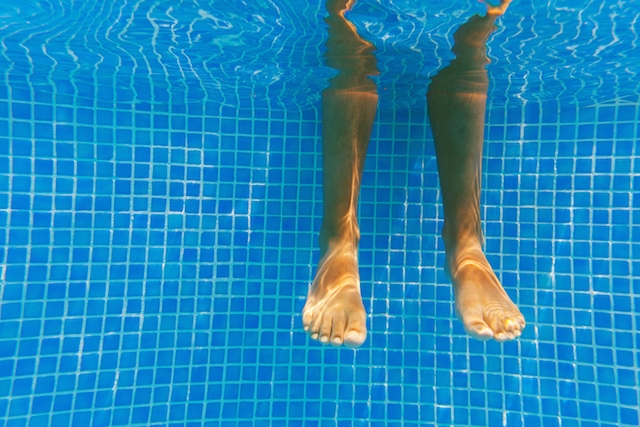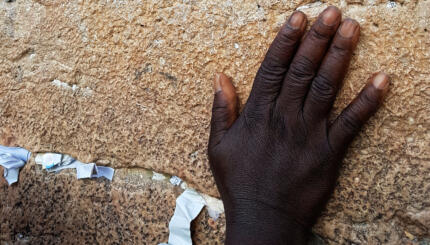What physical act could a person perform in order to symbolize a radical change of heart, a total commitment? Is there a sign so dramatic, dynamic, and all-encompassing that it could represent the radical change undergone by the convert to Judaism?
Jewish tradition prescribes a profound symbol. It instructs the conversion candidate to place himself or herself in a radically different physical environment–in water rather than air. This leaves the person floating–momentarily suspended without breathing–substituting the usual forward moving nature and purposeful stride that characterize his or her waking movements with an aimlessness, a weightlessness, a detachment from the former environment. Individuality, passion, ego–all are submerged in the metamorphosis from the larval state of the present to a new existence.
Ritual immersion is the total submersion of the body in a pool of water. This pool and its water are precisely prescribed by Jewish law. Immersion, tevillah, is the common core component of every [traditional] Jewish conversion process, for male and female, adult and child, ignoramus and scholar. It is sine qua non, and a conversion ceremony without immersion is unacceptable to the traditional religious community and simply not Jewish in character.
This requirement of immersion admits of no compromise, no matter where in the world one finds oneself. (While Conservative rabbis similarly require [sometimes pronounced mikvah] for conversion, Reform rabbis generally do not, although a tendency to more traditional symbols and a sense that a uniform conversion process is desirable are encouraging greater use of the immersion component even among the Reform.)

Help us keep Jewish knowledge accessible to millions of people around the world.
Your donation to My Jewish Learning fuels endless journeys of Jewish discovery. With your help, My Jewish Learning can continue to provide nonstop opportunities for learning, connection and growth.
Religious Functions of the Mikveh
Several religious functions are served by this powerful symbol of submerging in water. In the days of the ancient Temple in Jerusalem, the mikveh was used by all Jews who wanted to enter the precincts of the Sanctuary. The law required every person inside the Temple grounds to be in a spiritually pure state appropriate to the pristine spirituality of the Sanctuary itself.
Throughout Jewish history, unmarried women have immersed in the mikveh prior to their wedding; married women immerse at the end of seven days of stainless purity from the end of each monthly menstrual cycle, in preparation for the resumption of family relations in their most fertile days.
A major function of immersion in the mikveh is for conversion to Judaism. The sages declare that a gentile who wishes to become a Jew must undergo the identical process by which Jewish ancestors converted. As Jews performed immersion at Mt. Sinai to complete the conversion process they had begun with circumcision as they left Egypt, so converts in every age must immerse in a mikveh.
Water Symbolizes Birth as a Jew
Submerging in a pool of water for the purpose not of using the water’s physical cleansing properties but expressly to symbolize a change-of-soul is a statement at once deeply spiritual and immensely compelling. No other symbolic act can so totally embrace a person as being submerged in water, which must touch and cover every lesion, every strand of hair, every birthmark. No other religious act is so freighted with meaning as this one which touches every aspect of life and proclaims a total commitment to a new idea and a new way of life as it swallows up the old and gives birth to the new.
The water of the mikveh is designed to ritually cleanse a person from deeds of the past. The convert is considered by Jewish law to be like a newborn child. By spiritually cleansing the convert, the mikveh water prepares him or her to confront God, life, and people with a fresh spirit and new eyes–it washes away the past, leaving only the future. Of course, this does not deny that there were good and beautiful aspects of the past. But, in the strictest religious sense, that past was only prologue to a future life as a Jew.
There is a second layer of meaning to mikveh. It marks the beginning of the ascent to an elevated religious state. This function of mikveh goes beyond the basic purpose of purification. Anthropologists refer to this threshold of higher social status as “liminality.” The person at this moment of transition is a “liminal” or “threshold” person. The liminal state is common to virtually all persons and societies, ancient and modern, and it marks a move to an altered status or to a life transition. Entering adulthood from adolescence, for example, requires a tunnel of time, a rite of passage, a liminal state that acknowledges by symbolic acts the stark changes taking place in one’s self-identity, behavior, and attitude.
In a sense, it is nothing short of the spiritual drama of death and rebirth cast onto the canvas of the convert’s soul. Submerging into waters over her head, she enters into an environment in which she cannot breathe and cannot live for more than moments. It is the death of all that has gone before. As she emerges from the gagging waters into the clear air, she begins to breathe anew and live anew–as a baby struggling to be born.
If we take this graphic metaphor a step further, we can sense that the mikveh is a spiritual womb. The human fetus is surrounded by water. It does not yet live. The water breaks in a split second and the child emerges into a new world. “As soon as the convert immerses and emerges, he is a Jew in every respect” (Yevamot 47b).
What is a Mikveh, According to Jewish Law?
The mikveh must comply with a number of precise halachic [Jewish legal] qualifications. The mikveh must be built into the ground or the structure of the building. It must hold a minimum of 24 cubic feet of water–200 gallons. The depth must be such as to enable an average adult to stand upright and have the water reach at least 11 inches above the waist, so that immersion can be performed without backbreaking contortions.
The water must originally have been transported to the mikveh in a manner resembling the natural flow of waters. The general practice is to build cement channels at the sides of the mikveh roof, which will enable rainwater to flow directly into the mikveh. Done right the first time, with the required initial amount of water, other piped waters may be added later in whatever quantities and at any time, and the mikveh will still retain its religious validity.
The waters must be stationary and not flow (not even the flow caused by a filter) while the mikveh is in use. The water, by all means, should be chlorinated to assure its meeting the highest standards of hygienic cleanliness. (While the chlorinated water may be somewhat discolored, it does have to retain natural water color.)
Water deriving from a natural spring is considered a valid mikveh if it complies with halakhic conditions. Also quite proper is immersing in the ocean, where there is no mikveh available, given the satisfaction of certain halakhic conditions.
Parameters of the Mikveh Experience
The ceremony must take place on a weekday [and not on Shabbat, the Sabbath] and during daylight, as do all other Jewish court procedures. In cases when a full circumcision has to be performed (unlike the touch of blood for previously circumcised males), enough time will have to elapse to be certain that the wound has healed completely.
The only assurance that the immersion will accord with halakhic requirements for a male convert is the presence of the rabbi at the mikveh; a female is to be accompanied by a person familiar with the practice, such as a rabbi’s wife, the mikveh escort, or a very knowledgeable friend who herself uses the mikveh.
The body must be thoroughly cleansed immediately before the immersion. The convert should be careful that there are no adhesions such as bandages, Band-Aids, or ointment; that the hair is thoroughly brushed; the nails of the hands and feet are pared; and that no traces of cosmetics or nail polish remain. The whole body must be immersed at one time, not sequentially, and the submerging must be total, without even a single hair remaining above the water.
The Conversion Blessings and When They Are Recited
The blessing in the mikveh is as follows:
Barukh atah Ado-nai Elo-henu melekh ha’olam asher kideshanu b’mitzvotav v’tzivanu al ha’tevillah.
Blessed are You, O Lord, our God, King of the universe, who has sanctified us with His commandments and commanded us regarding the immersion.
Blessings over the performance of mitzvot [commandments] in Jewish life always take place before the action of the . The reason for this is that it focuses the soul, raising the consciousness for the action to be undertaken, establishing the purpose of the mitzvah, and demonstrating that its origins are in God’s command. Also, the blessing enhances the mitzvah by providing the reason for undertaking the symbolic action. Ritva [a medieval commentator] notes that, since the blessing is a statement of the soul, it should precede the statement made by the physical action of the body.
There is one exception to this general practice of placing the blessing before the
mitzvah–the immersion of a convert. The convert needs to recite the blessing after the immersion, not before. The reason is simple: One cannot declare “God commanded us”
if one is not commanded by God because he or she is not Jewish. The convert becomes a Jew only after the immersion is completed.
After the blessing, the convert immerses twice more and then leaves the mikveh.
A second blessing is required by most, but not all, authorities. It is called she’hecheyanu, and with it a person thanks God that He has enabled him to live to experience the greatness of this moment.
Excerpted with permission from Becoming a Jew (Jonathan David Publishers, Inc.).



